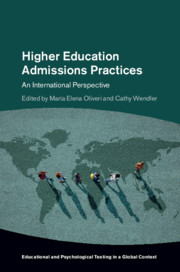Book contents
- Higher Education Admissions Practices
- Educational and Psychological Testing in a Global Context
- Higher Education Admissions Practices
- Copyright page
- Contents
- Figures
- Tables
- Contributors
- Series Editor’s Foreword
- Foreword
- Acknowledgments
- Part I Global Challenges and Common Admissions Models
- Part II Country-Specific Admissions Practices
- Part III Assessments Used in Higher Education Admissions
- Part IV Rethinking Higher Education Admissions
- Index
- References
Part II - Country-Specific Admissions Practices
Published online by Cambridge University Press: 09 January 2020
- Higher Education Admissions Practices
- Educational and Psychological Testing in a Global Context
- Higher Education Admissions Practices
- Copyright page
- Contents
- Figures
- Tables
- Contributors
- Series Editor’s Foreword
- Foreword
- Acknowledgments
- Part I Global Challenges and Common Admissions Models
- Part II Country-Specific Admissions Practices
- Part III Assessments Used in Higher Education Admissions
- Part IV Rethinking Higher Education Admissions
- Index
- References
Summary
For many countries, ensuring a well-educated population is a top priority. Higher levels of education result in benefits to both individuals and society at large. College admissions generally reflect societal values of a country. The underlying philosophy regarding who should be allowed to go to college or university, the criteria believed to be importantin determining which applicants get in and which do not, and how fairness and diversity are perceived often contribute to the shape of admissions procedures. The chapters in this section detail country-specific higher education admissions practices for a sample of countries and address a number of common themes such as access to college, diversity and fairness, and the validity of decision-making criteria.
Keywords
- Type
- Chapter
- Information
- Higher Education Admissions PracticesAn International Perspective, pp. 119 - 232Publisher: Cambridge University PressPrint publication year: 2020

